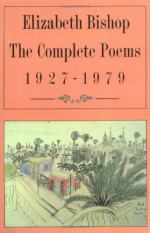
|
| Name: _________________________ | Period: ___________________ |
This test consists of 15 multiple choice questions and 5 short answer questions.
Multiple Choice Questions
1. Which technique is used in the speaker's claim to have lost "some realms I owned, two rivers, a continent" (line 14)?
(a) Hyperbole.
(b) Personification.
(c) Imagery.
(d) Simile.
2. Who is the author of "One Art"?
(a) Audre Lourde.
(b) Elizabeth Bishop.
(c) Sylvia Plath.
(d) Lucille Clifton.
3. What is the rhyme scheme of the first five stanzas of "One Art"?
(a) AAA.
(b) AAB.
(c) ABA.
(d) ABB.
4. What is the verb mood of line 4, "Lose something every day"?
(a) Interrogative.
(b) Subjunctive.
(c) Imperative.
(d) Indicative.
5. How many refrains does "One Art" contain?
(a) 4.
(b) 3.
(c) 2.
(d) 1.
6. What is the name of the metrical foot that appears at the end of lines 1 and 3 in most of the stanzas?
(a) Tribrach.
(b) Dactyl.
(c) Anapest.
(d) Amphibrach.
7. What is the format of "One Art"?
(a) Sonnet.
(b) Villanelle.
(c) Ballad.
(d) Sestina.
8. What does the colon at the end of line 7, "Then practice losing farther, losing faster," indicate about the "places, and names" in line 8?
(a) Places and names are more upsetting to lose than small objects and small amounts of time.
(b) Places and names are examples of things a person can only lose through "practice" and experience.
(c) Places and names are some of the last things that a person loses.
(d) Places and names are examples of things that can be lost "farther" and "faster."
9. What is the most reasonable interpretation of the speaker's line 13 claim that they have "lost two cities"?
(a) The speaker is no longer interested in either city.
(b) The speaker is not welcome in either city.
(c) The speaker no longer lives in either city.
(d) The speaker cannot find either city.
10. What is a reasonable statement to make about the effect of the enjambment in lines 8 and 9, "places, and names, and where it was you meant/ to travel"?
(a) It creates the sense of something being missing or lost because the thought is interrupted by enjambment.
(b) It creates an angry, agitated tone because of the isolation of the word "meant," which ends with a harsh sound.
(c) It creates a humorous effect because the words that complete the thought on line 9 are unexpected.
(d) It creates irony because the thought's completion on line 9 is actually the opposite of what the speaker means.
11. Which word in lines 10 and 11, "And look! my last,/ or next-to-last, of three loved houses went," creates a momentary shift in verb mood?
(a) The word "loved."
(b) The word "next."
(c) The word "look."
(d) The word "went."
12. What kind of metrical foot is the most frequent in "One Art"?
(a) Trochee.
(b) Dibrach.
(c) Iamb.
(d) Spondee.
13. What technique is employed in line 16, "Even losing you"?
(a) Dramatic irony.
(b) Apostrophe.
(c) Understatement.
(d) Sarcasm.
14. Stanzas four through six have which techniques in common?
(a) First person and indicative mood.
(b) First person and imperative mood.
(c) Second person and indicative mood.
(d) Second person and imperative mood.
15. Which is the best description of the tone of stanza one?
(a) Bewildered.
(b) Livid.
(c) Sanguine.
(d) Ebullient.
Short Answer Questions
1. What is the meaning of the word "fluster" in line 4?
2. In lines 2 and 3, "so many things seem filled with the intent/ to be lost that their loss is no disaster," what is the antecedent of the word "their"?
3. The relationship between stanza two and stanza three is most accurately expressed by which of the following?
4. In line 7, "Then practice losing farther, losing faster," rhythm is created through which devices?
5. What does the speaker use in line 5 as an example of a common lost object?
|
This section contains 629 words (approx. 3 pages at 300 words per page) |

|




